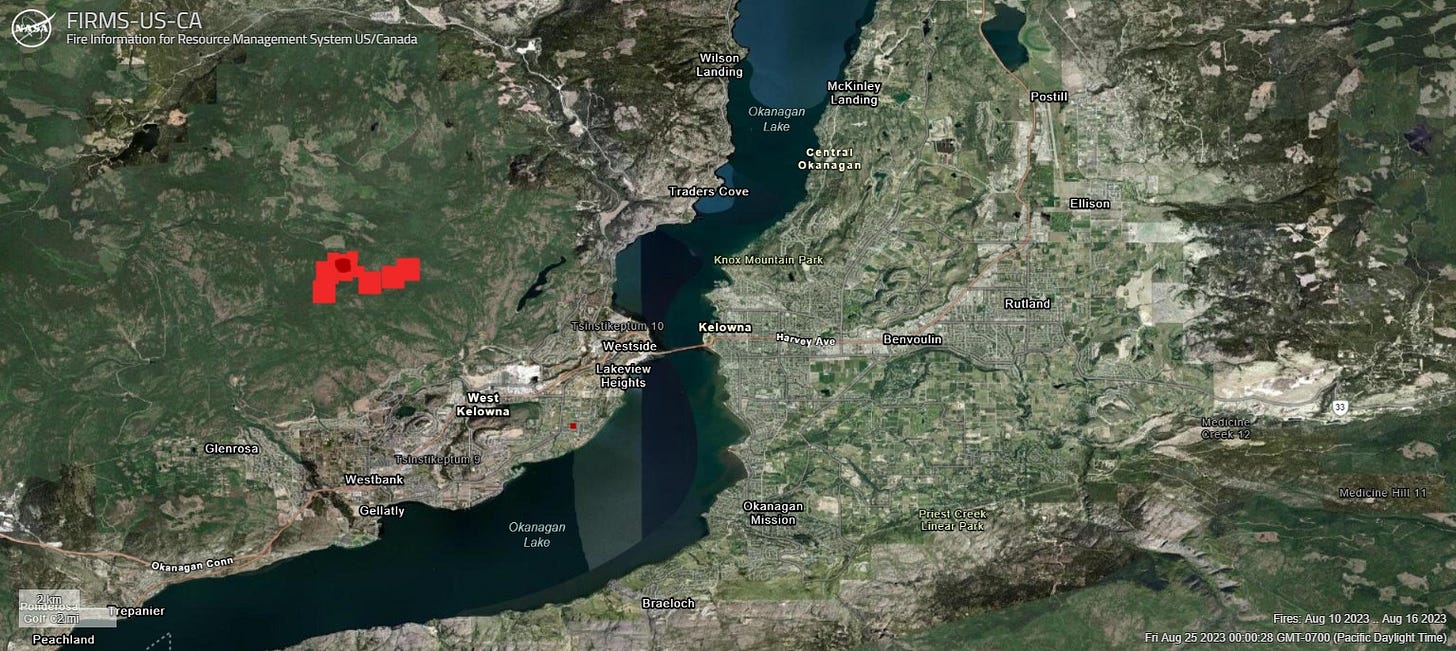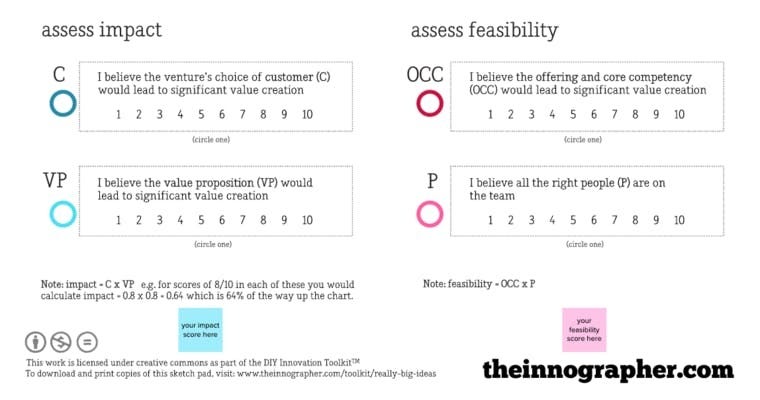This week I’m loving
There has been a lot not to love this week.
As you may know, the City of Kelowna, where I currently live, has made headlines around the world for the second huge and scary wildfire in North America in the past month.
Fire is a part of life in the Okanagan Valley. They happen every year and this one started like any other has in the 6 years I have lived there. A reported lightning strike last Wednesday night.
Image credit: NASA FIRMS US & Canada data, Aug 16, 2023
On the morning of August 17, 2023 we were up bright and early to begin our sojourn by car to Nanaimo BC for the BC Summer Swimming Association Provincial Championships. We drove through West Kelowna on our way out of town admiring beautiful blue skies and without any thought of the reported fire. No smoke or sign of anything to come.
By Friday night, our neighbourhood was being evacuated and our world was filled with uncertainty about whether anything would be left standing. Fueled by a perfect storm of wind and dry air, the fire had become an inferno affecting 3 communities.
Image credit: NASA FIRMS US & Canada data, Aug 18, 2023
So this week I want to give a shout out to some folks who are very often overlooked in these moments.
Emergency Managers.
Every city in North America that is large enough to have its own emergency response teams has them. And they are the world’s greatest project managers.
As an experienced project manager watching this disaster I can give no bigger love than to the emergency management teams who have been on the ground in Kelowna. This has been a masterclass in project management. And this masterclass has been given in the harshest of conditions.
The entire emergency management lifecycle follows the typical project management lifecycle.
Image credit: FEMA IS 300: Incident Action Planning Process (with overlay by Tager, 2022) as published on domesticpreparedness.com
Assembling the project team might require patience, as they may come from all over the country depending on the expertise required.
Instead of regular old stakeholders, you have distraught property owners and families wondering what they will come home to. This requires clear, effective, and efficient communication.
There is very little time to plan, so agile execution approaches need to be used, and need to be quickly taught and understood by personnel who are on the ground but not necessarily specialized in disaster response. Evacuating 15,000 people in a few hours with almost no warning of what would be required is the ultimate test of agile execution.
All the tactics and plans to manage the fire are subject to change at the whim of the weather and teams with limited communication have to be coordinated at a moment’s notice to keep everyone safe.
Emergency managers soon switch to the demands of monitoring and controlling. This supports communication needed to continue effective management of both responders and evacuees.
And finally, upon the glimpse of success, a whole new effort starts as it did while I write this, which is bringing people back to their property. This involves a whole new set of risks, safety management, and coordinated communication.
So let’s appreciate the impressive feats, and limited sleep of these folks who inspire us all to be better project managers in our own domains.
And let’s remember, that no project struggle that we face, is ever insurmountable when we can reference what has been accomplished in this past week.
P.S. My family has been incredibly lucky and it looks like we have escaped the losses suffered by many others in our community. If you are looking to support critical recovery for other families in my community please consider a donation to this incredible local charity Mamas for Mamas who will be helping the families that weren’t as lucky as mine.
Tool of the week
As promised last week, a continuation of the discussion of how to manage ideas for successful projects. If you missed last week’s edition you can read the post here.
Once your team has completed the Idea Sketchpad our next effort is to evaluate the idea. We call this the Idea Critique.
The best ideas to execute have two key dimensions. They are highly feasible for the organization to carry out and they are highly impactful.
The Idea Critique is designed to evaluate the idea documented on the Idea Sketchpad across 4 dimensions.
The customer
The value proposition
The offering & core competencies
The people
Image credit: Dr. Alex Bruton, The Innographer
Assemble a team that is different than the team who documented the idea. Better yet, have all the ideas potentially being considered documented and evaluated using this scoring tool by a consistent group of people.
Each dimension is scored on a scale of 10, with 10 being the best score.
Once each idea is scored, if you are evaluating multiple ideas, they can then be ranked by their score to give the team an idea of which ideas may be the best choice for investment.
Completing these two efforts at the beginning of the project provides concrete information supporting the business case and the project charter to help set the project off on the right foot.
Get your Idea Critique template here.
An interesting read
Today I learned a new word.
You should learn this word and what it means as a generalist.
Which means, you should read this article from the team at Generalist World.
One of the parts I find very interesting about my consulting practice is helping to shape disparate things into a unified whole. I do this on an individual level with teams where I am working on designing productive interactions that support strategic execution - the human chemistry within an organization. I probably enjoy this because of my Clifton Strength in Individualization. My gift is in helping figure out how different people can work together productively.
But I also like the challenge of doing this at the organizational level. This involves working with silos within an organization to create a unified whole. This is another dimension of organizational design that I like to call organizational chemistry. This is the magic of strategic execution - assembling disparate teams into a unified whole directed at the key value the organization can deliver.
What is your special talent?
A tip
This week on a Reddit thread, I was following someone who was struggling to figure out how to start out in project management. Admittedly, this can be a tricky effort. They were trying to weigh taking the Google Project Management Certificate, or the CAPM, and confused about whether they should instead focus on a PMP.
A lot of people were recommending the CAPM. But I thought this was short-sighted. The correct answer is: do both.
In fact, the Project Management Institute not only endorses the Google Project Management Certificate, but if you register to take the CAPM exam they will give you a discount on the Google Project Management Certificate.
You need 23 hours of certified education to write the CAPM exam - so this is a win-win for everyone.
Completed your Google Project Management Certificate? What did you think?
A lesson
This week’s lesson is about risk management. In particular, the hardest kind of risk to control for - the unknown unknown.
Popularized by former US Secretary of Defense Donald Rumsfeld, the “unknown unknown” is a risk that comes from situations so unexpected they would not be considered.
As we learned this week, a perfect storm can create a fire that could jump across Okanagan Lake.
How can we better handle these risks as project managers?
The firm answer, is you can’t ever get them all. The unknown is after all, the unknown. But, over time, your team can use a technique that may help you reduce the number of unknown unknowns.
This is scenario analysis.
First, the team should start by identifying all the scenarios they can think of.
You can draw these out in a mind map to help visualize the potential scenario alternates.
Next we travel around the mind map asking “what if” questions?
This should prompt the team to identify new scenarios that weren’t thought of in the first round. Map these, and repeat until you can’t identify any new scenarios.
And hopefully, you’ll be more prepared for the unexpected then you think.
I really hope you are enjoying this newsletter. I’m getting read to launch some other exciting stuff including resources to support your project management, another newsletter specifically focused on Value Delivery, and online courses. This community is a passion for me, and I’ll keep serving you here every week, but if you are interested in these other things, please sign up for my mailing list.







